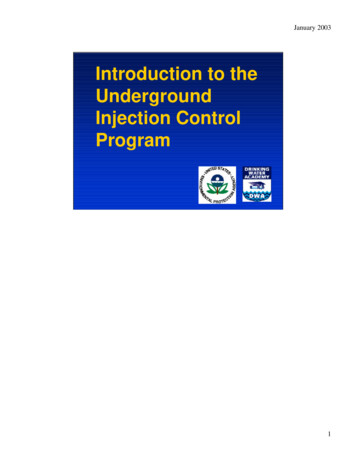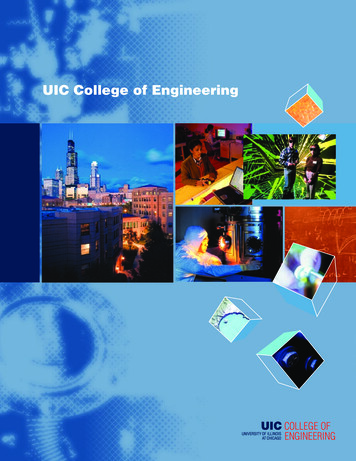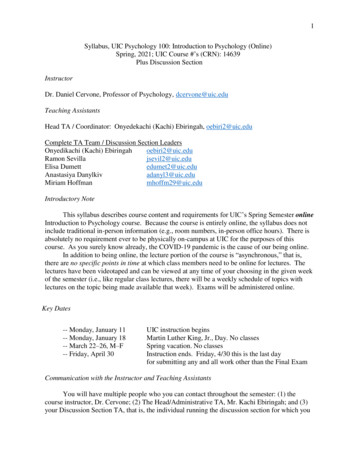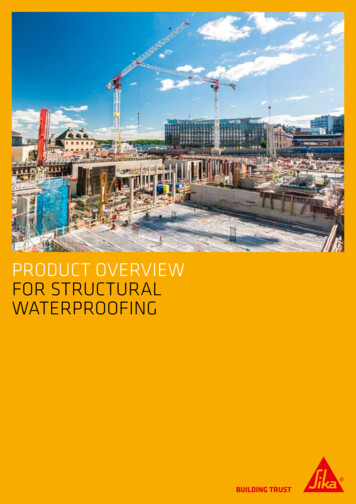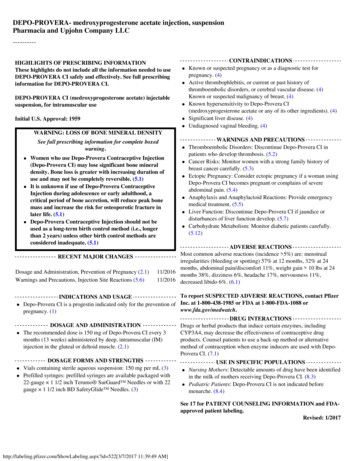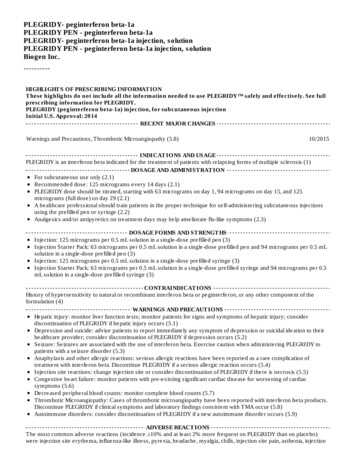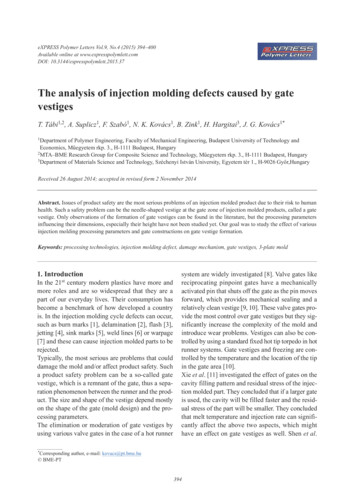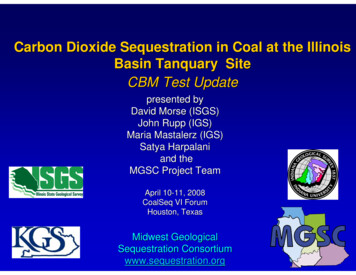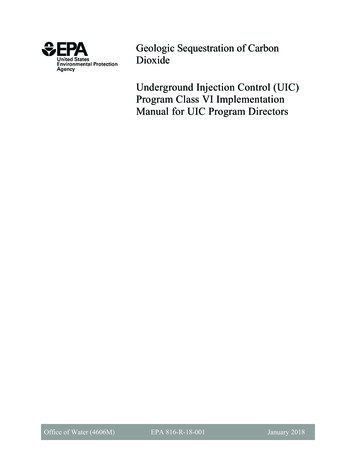
Transcription
Geologic Sequestration of CarbonDioxideUnderground Injection Control (UIC)Program Class VI ImplementationManual for UIC Program DirectorsOffice of Water (4606M)EPA 816-R-18-001January 2018
DisclaimerThe Class VI injection well classification was established by the Federal Requirements Underthe Underground Injection Control (UIC) Program for Carbon Dioxide (CO2) GeologicSequestration (GS) Wells (75 FR 77230, December 10, 2010), referred to as the Class VI Rule,which establishes a new class of injection well (Class VI).The Safe Drinking Water Act (SDWA) provisions and the United States EnvironmentalProtection Agency (EPA) regulations cited in this document contain legally-bindingrequirements. While the document recommends basic steps for reviewing project information, itacknowledges and is designed to accommodate potential site-specific considerations andregulatory flexibility inherent in the Class VI Rule. In several sections, this guidance documentmakes suggestions and offers alternatives that go beyond the minimum requirements indicatedby the Class VI Rule. This is intended to provide information and suggestions that may behelpful for implementation efforts. Such suggestions are prefaced by “may” or “should” and areto be considered advisory. They are not required elements of the Rule. Therefore, this documentdoes not substitute for those provisions or regulations, nor is it a regulation itself, so it does notimpose legally-binding requirements on the EPA, states, or the regulated community. Therecommendations herein may not be applicable to each and every situation.The EPA and state decision makers retain the discretion to adopt approaches on a case-by-casebasis that differ from this guidance where appropriate. Any decisions regarding a particularfacility will be made based on the applicable statutes and regulations. Mention of trade names orcommercial products does not constitute endorsement or recommendation for use. This guidancemay change in the future without a formal notice and comment period.While the EPA has made every effort to ensure the accuracy of the discussion in this document,the obligations of the regulated community are determined by statutes, regulations, or otherlegally-binding requirements. In the event of a conflict between the discussion in this documentand any statute or regulation, this document would not be controlling.Note that this document only addresses issues covered by the EPA’s authorities under SDWA.Other EPA authorities, such as Clean Air Act (CAA) requirements to report carbon dioxideinjection activities under the Greenhouse Gas Reporting Program (GHGRP), are not within thescope of this document.Underground Injection Control Program Class VI ImplementationManual for UIC Program Directorsii
Executive SummaryThe United States Environmental Protection Agency’s (EPA’s) Federal Requirements Under theUnderground Injection Control (UIC) Program for Carbon Dioxide (CO2) Geologic Sequestration(GS) Wells (75 FR 77230, December 10, 2010), and codified in the U.S. Code of Federal Regulations[40 CFR 146.81 et seq.], are known as the Class VI Rule. The Rule establishes a new class ofinjection wells (Class VI) and sets minimum federal technical criteria for Class VI injection wells forthe purpose of protecting underground sources of drinking water (USDWs).This UIC Program Class VI Implementation Manual for UIC Program Directors outlines anddescribes recommended activities to support Class VI permitting authorities in their review andevaluation of Class VI information over the course of a Class VI project. While the documentrecommends basic steps for reviewing project information, it acknowledges and is designed toaccommodate potential site-specific considerations and regulatory flexibility inherent in the Class VIRule. This Implementation Manual is intended to be used by Class VI permitting authorities inconjunction with a series of technical guidance documents that support Class VI injection well permitapplicants/owners or operators as they conduct required activities.The Manual is organized into the following sections: Section 1, Introduction, provides an overview of the Class VI requirements and Class VIprojects. It also describes the EPA-developed tools that can support the UIC ProgramDirector. Section 2, UIC Program Responsibilities, describes the roles and responsibilities the UICProgram has throughout the duration of a Class VI Project, including reviewing owner oroperator submittals, reporting and recordkeeping responsibilities, communicating about theproject, and assuring compliance with permit conditions. Section 3, Pre-Permitting Considerations, describes recommended steps that the UICProgram Director can take in advance of the formal submittal of a Class VI permitapplication, including assisting the applicant in gaining access to the Geologic SequestrationData Tool (GSDT) and addressing specific topics on which pre-application discussionsshould be focused. Section 4, Reviewing Pre-Construction Information, describes recommended steps tofacilitate the evaluation of information submitted in a Class VI permit application, issue adraft permit, and authorize construction or conversion of an injection well. Section 5, Reviewing Pre-Operation Information, presents recommendations to the UICProgram for reviewing final geologic data and the results of pre-operational testing and,based on this review, authorizing operation of the Class VI well. Section 6, Injection Phase Review, presents recommendations for ensuring that the project isprotective of USDWs during injection operations by reviewing testing and monitoring data,evaluating area of review (AoR) reevaluations, and reviewing project plan updates. Section 7, Post-Injection Phase Review, describes recommendations regarding how the UICProgram Director should evaluate the information that owners or operators submit during thepost-injection phase, including well plugging reports, post-injection monitoring data, nonendangerment demonstrations, and site closure reports.Underground Injection Control Program Class VI ImplementationManual for UIC Program Directorsiii
Table of ContentsExecutive Summary . iiiTable of Contents . ivList of Figures . viList of Tables . viiList of Appendices . viiiAcronyms and Abbreviations . ixDefinitions. x1 Introduction . 1-11.1 Document Purpose . 1-11.2 UIC Class VI Program Background . 1-21.3 UIC Class VI Project Overview. 1-31.4 Available Resources to Support Class VI Permitting . 1-42 UIC Program Responsibilities . 2-12.1 Reviewing/Evaluating Submittals and Decision-Making . 2-12.2 Reporting to the EPA . 2-42.3 Communicating about Class VI Projects . 2-52.4 Ensuring Compliance with the Class VI Rule . 2-93 Pre-Permitting Considerations . 3-13.1 Class VI Permitting Preparations . 3-13.2 Permit Applicant Engagement . 3-23.3 Communication and Outreach . 3-83.4 Other Pre-Permitting Considerations . 3-94 Reviewing Pre-Construction Information . 4-14.1 Evaluation of Pre-Construction Information . 4-24.1.1 Site Characterization . 4-44.1.2 AoR and Corrective Action . 4-174.1.3 Financial Responsibility. 4-234.1.4 Injection Well Construction . 4-284.1.5 Pre-Operational Testing . 4-334.1.6 Proposed Operating Conditions . 4-364.1.7 Testing and Monitoring. 4-394.1.8 Injection Well Plugging . 4-454.1.9 Post-Injection Site Care and Site Closure . 4-474.1.10 Emergency and Remedial Response . 4-514.1.11 Injection Depth Waivers . 4-534.1.12 Aquifer Exemption Expansions . 4-594.2 Preparing the Permit . 4-634.3 Planning for the Pre-Operation Review . 4-65Underground Injection Control Program Class VI ImplementationManual for UIC Program Directorsiv
5 Reviewing Pre-Operation Information . 5-15.1 Evaluation of Pre-Operation Information . 5-25.1.1 Site Characterization . 5-45.1.2 AoR and Corrective Action . 5-95.1.3 Financial Responsibility. 5-135.1.4 Injection Well Construction . 5-155.1.5 Operating Conditions . 5-185.1.6 Testing and Monitoring. 5-205.1.7 Injection Well Plugging . 5-225.1.8 Post-Injection Site Care and Site Closure . 5-245.1.9 Emergency and Remedial Response . 5-275.1.10 Injection Depth Waivers . 5-285.2 Authorizing Injection . 5-305.3 Planning for the Injection Phase Review . 5-326 Injection Phase Review . 6-16.1 Testing and Monitoring . 6-16.1.1 Characteristics of the Carbon Dioxide Stream. 6-26.1.2 Continuous Monitoring Data . 6-36.1.3 Corrosion Monitoring Results. 6-56.1.4 Groundwater Quality Monitoring . 6-66.1.5 External MITs . 6-86.1.6 Pressure Fall-Off Test Results . 6-96.1.7 Plume and Pressure Front Tracking Information . 6-106.1.8 Surface Air and/or Soil Gas Monitoring . 6-126.1.9 Other Required Monitoring. 6-136.2 AoR Reevaluations . 6-146.3 Project Plan Updates . 6-196.4 Financial Responsibility Updates . 6-226.5 Occasional Injection-Phase Reviews . 6-246.5.1 Workovers, Stimulation, or Other Well Tests . 6-246.5.2 Emergency Response . 6-256.5.3 Notification of Adverse Financial Conditions . 6-286.6 Planning for the Post-Injection Phase Review . 6-287 Post-Injection Phase Review . 7-17.1 Injection Well Plugging . 7-27.2 Reviewing Post-Injection Site Care Information . 7-37.2.1 PISC and Site Closure Plan Amendments . 7-47.2.2 Post-Injection Monitoring . 7-67.3 AoR Reevaluations . 7-97.4 Project Plan Updates . 7-107.5 Emergency and Remedial Response . 7-117.6 Non-Endangerment Demonstrations. 7-117.7 Site Closure . 7-14Underground Injection Control Program Class VI ImplementationManual for UIC Program Directorsv
List of FiguresFigure 1-1: Overview of the Federal Class VI Rule Requirements . 1-2Figure 1-2: The Phases of a Class VI Project . 1-5Figure 2-1: Data Evaluations and Decision-Making . 2-2Figure 2-2: Class VI Project Communications . 2-5Figure 3-1: Reviewing Class VI Permit Applications and Injection Depth WaiverApplications . 3-7Figure 4-1: Site Characterization Review . 4-5Figure 4-2: Examples of Class VI Groundwater Monitoring and Plume and Pressure FrontTracking Activities. 4-42Figure 4-3: Geologic Scenarios for Injection Depth Waivers . 4-54Figure 6-1: Reviewing Testing and Monitoring Results . 6-2Figure 6-2: AoR Reevaluations . 6-14Figure 7-1: Reviewing Non-Endangerment Demonstrations . 7-13Underground Injection Control Program Class VI ImplementationManual for UIC Program Directorsvi
List of TablesTable 1-1: Templates to Facilitate Compliance with Federal Class VI Rule Requirements . 1-6Table 4-1: Examples of Cross-Submittal Checks for Conducting Technical Evaluations ofClass VI Permit Applications. 4-2Table 4-2: Financial Instruments Recommended in the UIC Program Class VI FinancialResponsibility Guidance . 4-26Table 5-1: Examples of how Pre-Operational Submittals can Inform Considerations forIssuing Authorization to Inject at a Class VI Well . 5-3Underground Injection Control Program Class VI ImplementationManual for UIC Program Directorsvii
List of AppendicesAppendix A: The Geologic Sequestration Data Tool . A-1Appendix B: Useful Websites .B-1Underground Injection Control Program Class VI ImplementationManual for UIC Program Directorsviii
Acronyms and SDWUSGSArea of Potential ImpactArea of ReviewClean Air ActCarbon Capture and StorageComprehensive Environmental Response, Compensation, and Liability ActCode of Federal RegulationsCasing Inspection LogCross-Media Electronic Reporting RegulationEnhanced Gas RecoveryEnvironmental JusticeEnhanced Oil RecoveryU.S. Environmental Protection AgencyElectronic Signature AgreementGreenhouse Gas Reporting ProgramGeographic Information SystemGeologic SequestrationGeologic Sequestration Data ToolLog ASCII StandardMilligrams per literMechanical Integrity TestMarine Protection, Research, and Sanctuaries ActNational Risk Assessment PartnershipOuter Continental Shelf Lands ActProgram Activity MeasurePost-Injection Site CareParts per MillionPublic Water System Supervision Program (under SDWA)Quality AssuranceQuality Assurance Surveillance PlanResource Conservation and Recovery ActSafe Drinking Water ActSafe Drinking Water Information SystemSignificant NoncomplianceSubsurface Transport over Multiple PhasesTotal Dissolved SolidsTransport of Unsaturated Groundwater and HeatUnderground Injection ControlUnderground Source of Drinking WaterUnited States Geological SurveyUnderground Injection Control Program Class VI ImplementationManual for UIC Program Directorsix
DefinitionsKey to definition sources:1: 40 CFR 144.3.2: 40 CFR 146.81(d).3: 40 CFR 144.6(f) and 144.80(f).4: This definition was developed for the purposes of this document.5: Class VI Rule Preamble (75 FR 77230).Administrator means the Administrator of the United States Environmental Protection Agency,or an authorized representative.1Area of Review (AoR) means the region surrounding the geologic sequestration project whereUSDWs may be endangered by the injection activity. The area of review is delineated usingcomputational modeling that accounts for the physical and chemical properties of all phases ofthe injected carbon dioxide stream and displaced fluids, and is based on available sitecharacterization, monitoring, and operational data as set forth in 40 CFR 146.84.2Carbon dioxide plume means the extent underground, in three dimensions, of an injectedcarbon dioxide stream.2Carbon dioxide stream means carbon dioxide that has been captured from an emission source(e.g., a power plant), plus incidental associated substances derived from the source materials andthe capture process, and any substances added to the stream to enable or improve the injectionprocess. This subpart [subpart H of 40 CFR 146] does not apply to any carbon dioxide streamthat meets the definition of a hazardous waste under 40 CFR 261.2Class VI wells means wells that are not experimental in nature that are used for geologicsequestration of carbon dioxide beneath the lowermost formation containing a USDW; or, wellsused for geologic sequestration of carbon dioxide that have been granted a waiver of theinjection depth requirements pursuant to requirements at 40 CFR 146.95; or, wells used forgeologic sequestration of carbon dioxide that have received an expansion to the areal extent of anexisting Class II enhanced oil recovery or enhanced gas recovery aquifer exemption pursuant to40 CFR 146.4 and 144.7(d).3Confining zone means a geologic formation, group of formations, or part of a formationstratigraphically overlying the injection zone(s) that acts as barrier to fluid movement. For ClassVI wells operating under an injection depth waiver, confining zone means a geologic formation,group of formations, or part of a formation stratigraphically overlying and underlying theinjection zone(s).2Corrective action means the use of Director-approved methods to ensure that wells within thearea of review do not serve as conduits for the movement of fluids into underground sources ofdrinking water (USDW).2Geologic sequestration (GS) means the long-term containment of a gaseous, liquid, orsupercritical carbon dioxide stream in subsurface geologic formations. This term does not applyto carbon dioxide capture or transport.2Underground Injection Control Program Class VI ImplementationManual for UIC Program Directorsx
Geologic sequestration project means an injection well or wells used to emplace a carbondioxide stream beneath the lowermost formation containing a USDW; or, wells used for geologicsequestration of carbon dioxide that have been granted a waiver of the injection depthrequirements pursuant to requirements at 40 CFR 146.95; or, wells used for geologicsequestration of carbon dioxide that have received an expansion to the areal extent of an existingClass II enhanced oil recovery or enhanced gas recovery aquifer exemption pursuant to 40 CFR146.4 and 144.7(d). It includes the subsurface three-dimensional extent of the carbon dioxideplume, associated area of elevated pressure, and displaced fluids, as well as the surface areaabove that delineated region.2Geophysical surveys refer to the use of geophysical techniques (e.g., seismic, electrical, gravity,or electromagnetic surveys) to characterize subsurface rock formations.5Injection depth waiver refers to a waiver of the Class VI injection depth requirements by theUIC Program Director pursuant to the provisions at 40 CFR 146.95.4Injection zone means a geologic formation, group of formations, or part of a formation that is ofsufficient areal extent, thickness, porosity, and permeability to receive carbon dioxide through awell or wells associated with a geologic sequestration project.2Injectivity is the pressure differential over existing reservoir pressure required to inject a unitvolume of fluid in a given unit of time. It is typically expressed as psi/bbl/day (psi per barrel perday), but can be expressed in any combination of pressure, volume, and time units.4Mechanical integrity testing (MIT) refers to a test performed on a well to confirm that a wellmaintains internal and external mechanical integrity. MITs are a means of measuring theadequacy of the construction of an injection well and a way to detect problems within the wellsystem.5Phased corrective action refers to a provision of the Class VI Rule [40 CFR 146.84(b)(2)(iv)]afforded to Class VI injection well owners or operators to defer some identified corrective actionneeded within the AoR, but farther away from the injection well, until after injection hascommenced, but prior to carbon dioxide plume and pressure front movement into that particulararea.4Plug means a watertight, gastight seal installed in a borehole or well to prevent movement offluids; it may be mechanical or composed of cement or other materials capable of zonalisolation.4Post-injection site care (PISC) means the appropriate monitoring and other actions (includingcorrective action) needed following cessation of injection to ensure that USDWs are notendangered, as required under 40 CFR 146.93.5Pressure front means the zone of elevated pressure that is created by the injection of carbondioxide into the subsurface. The pressure front of a carbon dioxide plume refers to a zone wherethere is a pressure differential sufficient to cause the movement of injected fluids or formationfluids into a USDW.2Site closure means the point/time, as determined by the Director following the requirementsunder 40 CFR 146.93, at which the owner or operator of a geologic sequestration site is releasedfrom post-injection site care responsibilities.2Underground Injection Control Program Class VI ImplementationManual for UIC Program Directorsxi
Transmissive fault or fracture means a fault or fracture that has sufficient permeability andvertical extent to allow fluids to move between formations.2Underground Injection Control (UIC) Program refers to the program the EPA, or anapproved state or tribe, is authorized to implement under the Safe Drinking Water Act (SDWA)and that is responsible for regulating the underground injection of fluids by well injection.4UIC Program Director refers to the person responsible for permitting, implementation, andcompliance of the UIC Program. For UIC programs administered by the EPA, the UIC ProgramDirector is the EPA Regional Administrator or his/her delegatee; for UIC programs in primacystates, the UIC Program Director is the person responsible for permitting, implementation, andcompliance of the state, territorial, or tribal UIC program.5Underground Source of Drinking Water (USDW) means an aquifer or its portion whichsupplies any public water system; or which contains a sufficient quantity of groundwater tosupply a public water system; and currently supplies drinking water for human consumption; orcontains fewer than 10,000 mg/L total dissolved solids; and which is not an exempted aquifer.1Underground Injection Control Program Class VI ImplementationManual for UIC Program Directorsxii
Section 1: IntroductionIntroduction
This page is intentionally blank.Introduction
1IntroductionThe United States Environmental Protection Agency’s (EPA’s) Federal Requirements Under theUnderground Injection Control (UIC) Program for Carbon Dioxide Geologic Sequestration(GS) Wells, found at 75 FR 77230, December 10, 2010, and codified in the U.S. Code of FederalRegulations [40 CFR 146.81 et seq.], are referred to as the Class VI Rule. The Class VI Rule,promulgated under the authority of the Safe Drinking Water Act (SDWA, 42 U.S.C. §300h etal.), outlines federal requirements for the permitting, siting, construction, operation, monitoring,and site closure of Class VI injection wells, which are used to inject carbon dioxide for GS.The UIC Program Director is responsible for ensuring that owners or operators of Class VI wellsproperly site, operate, monitor, and close their wells in a manner that protects undergroundsources of drinking water (USDWs) from endangerment. Throughout the duration of a Class VIproject, permitting authorities are responsible for ensuring that: Class VI wells are sited and constructed such that USDWs are protected, considering siteand project-specific information collected in the pre-permitting, pre-construction and preoperation phases; Class VI wells operate as planned and in compliance with the regulations as verified bytesting and monitoring, in a manner that is protective of USDWs during the injectionphase; and Post-injection monitoring is conducted until a USDW non-endangerment demonstrationis made and approved by the UIC Program Director, the injection well and all monitoringwells are plugged, and the site is closed.To achieve these goals, UIC Program Directors’ activities include: reviewing Class VI permitapplications; writing and issuing permits; authorizing injection; documenting decision-making;reviewing testing and monitoring data, the results of Area of Review (AoR) reevaluations, andother reports; responding to emergency situations or violations; addressing compliance issues;authorizing and approving site
Manual for UIC Program Directors . Disclaimer . The Class VI injection well classification was established by the . Federal Requirements Under the Underground Injection Control (UIC) Program for Carbon Dioxide (CO. 2) Geologic Sequestration (GS) Wells (75 FR 77230, December 10, 2010), referred to as the Class VI Rule,

